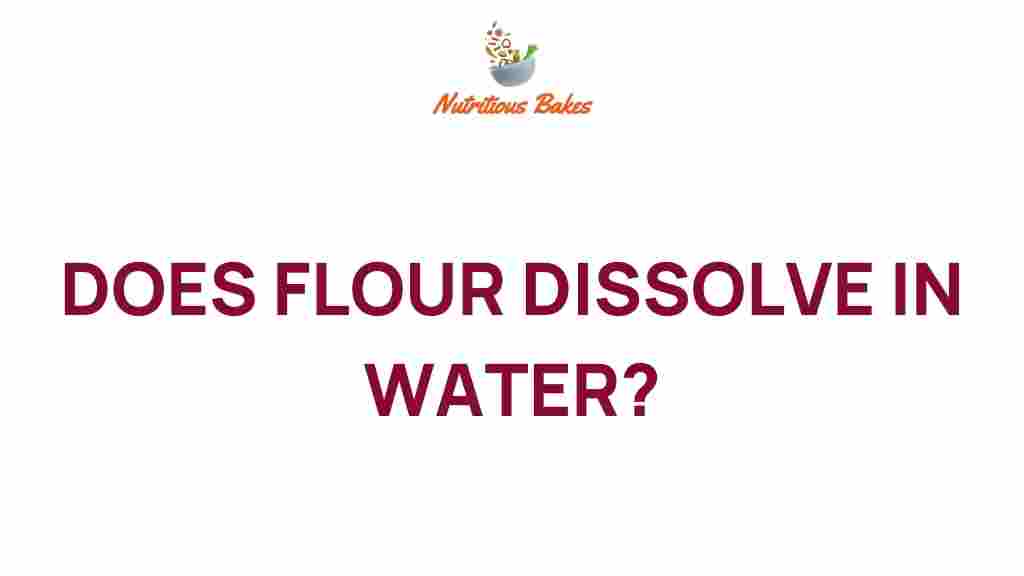The Surprising Science: Does Flour Dissolve in Water?
When it comes to cooking, understanding the properties of ingredients can make a significant difference in the outcome of your dishes. One such ingredient is flour, a staple in many kitchens around the world. While flour is commonly used in various culinary techniques, one question often arises: does flour dissolve in water? This article delves into the science behind flour and water, exploring their interaction, the implications for cooking, and conducting simple kitchen experiments to illustrate these principles.
Understanding Flour and Water Interaction
Flour is primarily made up of starches, proteins, and a small amount of fat. When mixed with water, flour does not truly dissolve in the same way that salt or sugar does. Instead, the flour particles hydrate and swell, leading to a thickening effect rather than a complete dissolution.
Here’s a quick breakdown of what happens when flour meets water:
- Hydration: Water molecules penetrate the flour particles, causing them to absorb moisture.
- Swelling: As flour absorbs water, the starch granules swell, creating a gel-like texture.
- Gluten Development: The proteins in flour (mainly glutenin and gliadin) start to interact when kneaded, forming gluten, which provides structure and elasticity in baked goods.
The Science Behind Dissolving
To understand whether flour dissolves in water, we need to consider how substances interact at a molecular level. Dissolving occurs when the molecules of a substance separate and disperse uniformly in a solvent. In the case of flour:
- Flour particles do not break down into individual molecules.
- Instead, they form a suspension, where flour particles remain intact but are surrounded by water.
This distinction is crucial for bakers and cooks, as it affects how flour is used in various recipes.
Cooking Techniques Utilizing Flour and Water
Flour and water are used in a variety of culinary techniques. Here are a few examples:
- Making Dough: Flour is mixed with water to create dough for bread, pasta, and pastries. The water activates the gluten, allowing for elasticity and structure.
- Thickening Sauces: A flour-water mixture (often called a slurry) can be used to thicken sauces and gravies.
- Batters: Flour combined with water (and other ingredients) creates batters for frying, such as tempura or pancake batter.
Step-by-Step Process: Mixing Flour and Water
Let’s explore a simple kitchen experiment to observe the interaction between flour and water. This will help you understand how flour behaves when mixed with water.
Materials Needed
- All-purpose flour
- Water (room temperature)
- A mixing bowl
- A spoon or whisk
Instructions
- Measure the Flour: Start with one cup of all-purpose flour.
- Add Water: Gradually pour in half a cup of water while stirring continuously.
- Observe: Notice how the flour absorbs the water and swells. You should see clumps forming, but it will not fully dissolve.
- Knead: If you want to create dough, continue to knead the mixture with your hands for about 5 minutes. Observe how the texture changes as gluten develops.
Troubleshooting Common Issues
When working with flour and water, you may encounter some common issues. Here are some troubleshooting tips:
- Too Dry: If the mixture is too dry and crumbly, add more water a tablespoon at a time until the desired consistency is reached.
- Too Wet: Conversely, if the mixture is too wet, gradually add more flour until it reaches the right texture.
- Clumps Forming: If you notice clumps of flour that are not mixing in, try using a whisk or a sifter to break them up before adding water.
Experimenting with Different Types of Flour
Different types of flour can yield various textures and results when mixed with water. Consider trying:
- Whole Wheat Flour: This flour has a higher fiber content, which can affect the hydration process.
- Gluten-Free Flour: These flours behave differently in water and often require additional binders to achieve a similar texture.
- Self-Rising Flour: This contains added leavening agents, which can alter the way it interacts with water.
Conclusion: Flour and Water in Culinary Science
In conclusion, flour does not dissolve in water in the traditional sense. Instead, it hydrates and swells, leading to various textures and consistencies essential for cooking and baking. Understanding this interaction is crucial for any culinary enthusiast looking to master their craft.
By experimenting with flour and water, you can gain valuable insights into the science of cooking. Whether you’re making bread dough, thickening a sauce, or creating a batter, recognizing how flour behaves in water will enhance your culinary skills.
For more information on food science and culinary techniques, check out this comprehensive guide on cooking fundamentals.
Remember, the kitchen is your laboratory! Embrace the science of cooking, and don’t hesitate to conduct your experiments. Happy cooking!
For further reading on the properties of flour and its uses in the kitchen, visit this authoritative source.
This article is in the category Tips and created by NutritiousBakes Team
